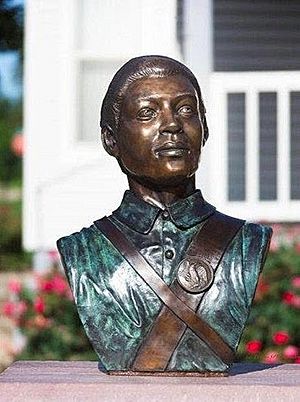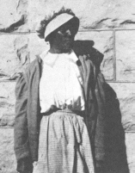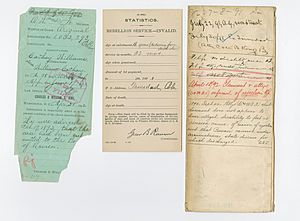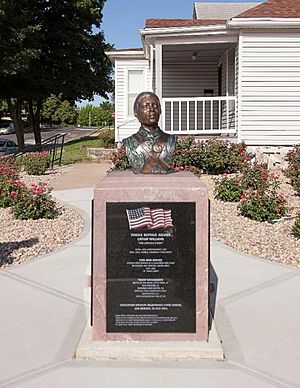Cathay Williams facts for kids
Quick facts for kids
Cathay Williams
|
|
|---|---|

Painting of Cathay Williams by William Jennings from the U.S. Army Profiles of Bravery
|
|
| Born | September 1844 |
| Died | 1924 (aged 81–82) |
| Nationality | American |
| Other names | John Williams, William Cathay |
| Occupation | Soldier, cook, seamstress |
| Employer | U.S. government, self-employed |
| Military career | |
| Allegiance | |
| Years of service | 1866–1868 |
| Rank | private |
| Unit | 38th U.S. Infantry Regiment, U.S. Army (Buffalo soldier) |
Cathay Williams (born September 1844 – died 1924) was an amazing African-American soldier. She joined the United States Army by pretending to be a man named William Cathay. She was the first Black woman to ever enlist in the U.S. Army. She was also the only known woman to serve as a soldier while disguised as a man during the American Indian Wars.
Contents
Early Life and the Civil War
Cathay Williams was born in Independence, Missouri. Her mother was enslaved, so Cathay was also born into slavery. As a teenager, she worked as a house slave on a plantation near Jefferson City, Missouri.
In 1861, the Civil War began. Union soldiers took over Jefferson City. During the war, enslaved people who were captured by the Union army were called "contraband." Many of them had to work for the military. They often served as cooks, laundresses, or nurses.
It's possible that Cathay Williams was present at some battles. These include the Battle of Pea Ridge and the Red River Campaign. However, there is no clear proof that she served as a soldier during the Civil War itself.
Joining the U.S. Army
Even though women were not allowed to join the military, Cathay Williams decided to enlist. On November 15, 1866, she joined the United States Army. She used the fake name "William Cathay" and pretended to be a man. She signed up for three years of service in St. Louis, Missouri.
She passed a quick medical check-up. Then, she was assigned to the 38th United States Infantry Regiment. Only two people knew her secret: her cousin and a friend. Both of them were also soldiers in her regiment.
Soon after joining, Williams got smallpox and had to go to the hospital. After she recovered, she rejoined her unit. They were stationed in New Mexico.
Leaving the Army
After some time, Cathay's body began to show signs of strain. This might have been because of the smallpox, the hot New Mexico weather, or years of marching. She was often sick and had to go to the hospital.
Eventually, the army doctor at her post found out she was a woman. He told her commanding officer, Captain Charles E. Clarke. Because of this, she was officially discharged from the Army on October 14, 1868.
Life After the Military
After leaving the army, Cathay Williams worked as a cook. She first worked at Fort Union, New Mexico. Later, she moved to Pueblo, Colorado.
Williams got married, but it did not end well. Her husband stole her money and horses. She had him arrested. After that, she moved to Trinidad, Colorado. There, she worked as a seamstress, making clothes. She might have also run a boarding house.
It was in Trinidad that her amazing story became public. A reporter from St. Louis heard rumors about an African-American woman who had served in the army. He came to interview her. Her life story and military service were published in The St. Louis Daily Times on January 2, 1876.
Around 1889 or 1890, Cathay Williams was in a local hospital for some time. In June 1891, she asked for a disability pension. This was money given to soldiers who were hurt or sick because of their service. The exact reason for her illness is not known. Other women soldiers from earlier wars, like Deborah Sampson, had received pensions.
Later Years and Legacy
In September 1892, a doctor from the U.S. Pension Bureau examined Cathay Williams. She was suffering from neuralgia (nerve pain) and diabetes. She also had all her toes removed and could only walk with a crutch. However, the doctor decided she did not qualify for disability payments. Her request was denied.
The exact date Cathay Williams died is not known for sure. It is thought she passed away shortly after her pension was denied, probably in 1893. However, some records suggest she might have lived until 1924, possibly dying in Raton at 82 years old. Her grave marker was likely made of wood and is now gone, so her final resting place is unknown.
Honors
Even though her final resting place is unknown, Cathay Williams is remembered for her bravery.
- In 2016, a bronze statue of Cathay Williams was placed outside the Richard Allen Cultural Center in Leavenworth, Kansas. It includes information about her life.
- In 2018, a special bench honoring Private Cathay Williams was unveiled. It is located on the Walk of Honor at the National Infantry Museum.
See also
 In Spanish: Cathay Williams para niños
In Spanish: Cathay Williams para niños






